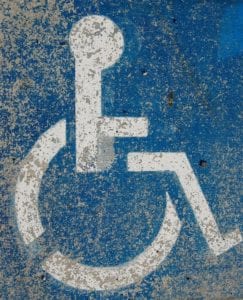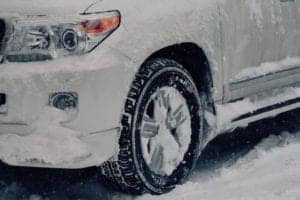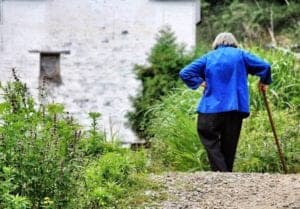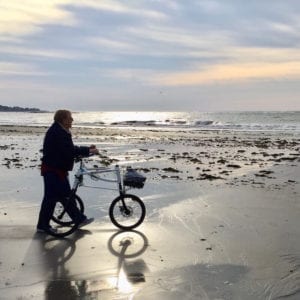How to Accept an Assistive Device with Grace
 Is There a Cane or Walker in Your Future?
Is There a Cane or Walker in Your Future?
The first time you find yourself in need of an assistive device like a cane or walker it can be devastating.
It need not be so.
Every journey has its need for specialized gear, and the glorious road ahead is just waiting for travelers who are prepared for the adventure.
For better or worse, we may have uninvited companions on this trip that we must accommodate.
Their names are Balance and Fatigue, twins with several siblings in tow with names like Pain and Anxiety.
They can arrive at any age for any number of reasons.
Our challenge is how to allow them in the car without letting them drive. (Thank you, Brene Brown, for this image.)
Just yesterday, we may have run a marathon and danced the samba.

Climbing on a step stool to reach the top shelf presented no more significant challenge than reaching down to pick up a nickel from the floor.
Then, like adding one more piece to a towering stack of colorful wooden blocks, the whole bundle comes barreling down with as much grace as an inebriated three-legged giraffe.
(Photo by Ryan Fields on Unsplash)
When Walking Gets Challenging
The litany of reasons why walking becomes a challenge as we age reads like a bad novel.
Indeed, conditions like Parkinson’s disease or neuropathy impact our relationship with gravity in new ways.
But so does lack of conditioning.
For some people, the breakdown of joints that held them together for decades becomes their nemesis.
 For others, a change in eyesight throws the world into so much distortion that it is hard to tell up from down, let alone move safely through the jungle of each day.
For others, a change in eyesight throws the world into so much distortion that it is hard to tell up from down, let alone move safely through the jungle of each day.
For people who live a sedentary lifestyle, challenges arise when they have to accommodate uneven surfaces when going for a walk. (Photo by Dasha-Yukhymyuk on Unsplash)
Sit too much, and the brain loses it’s GPS for the micro-adjustments of navigating safely in the world.
How We Adapt to Challenges
One key to maintaining balance in any of these scenarios lies in how we adapt.
 When I go outside in icy conditions, I equip my car with snow tires and my feet with ice grippers to keep a grip on the road.
When I go outside in icy conditions, I equip my car with snow tires and my feet with ice grippers to keep a grip on the road.
Pretty standard response if you live where the ground surface freezes in the winter.
Everyone does it, so I don’t stand out in a crowd. (Photo by Hossein Soltanloo on Unsplash)
 However, when I go for a walk on a perfectly sunny day using a cane, or heaven forbid, a walker(!), I am aware fewer people have a need to adapt to the obstacles in their world this way, and so I feel self-conscious.
However, when I go for a walk on a perfectly sunny day using a cane, or heaven forbid, a walker(!), I am aware fewer people have a need to adapt to the obstacles in their world this way, and so I feel self-conscious.
The problem isn’t in the equipment.
The problem is one of perception and change…and fear.
(Photo by Chastagner-Thierry on Unsplash
It is difficult to let go of who we are to embrace who we are becoming. (See “The Art of Letting Go”).
Especially if we see our new ‘self’ as limited or different from others.
I was in my 20’s the first time I was handed a ‘mobility device.’
I was devastated.
I didn’t want to walk slow.
I didn’t want to be one of ‘them’…people who are limited and, well…different.
I was a lot older before I fully understood and learned to celebrate that we are all limited in some way, and we are entirely different!
Can You Name What You Really Want?
Then I thought about what I wanted in this journey called life.
Any trip, metaphorical or not, is about getting from point A to point B.
A young woman who sets out in winter in New England is going to travel differently than a retired couple who live in the Arizona desert.
They travel in unique styles because they are different people in different situations.
Life became a whole lot simpler when I was able to name what it was I really wanted in life.
Simply, that is to get from Point A to Point B.
Whatever is waiting for me at Point B is moot if I can’t get there.
 But once I arrive, my options are endless!
But once I arrive, my options are endless!
Suddenly it didn’t matter so much if that was by cane or by wheels.
I would use whatever was necessary for the conditions I found myself in.
I still do that today. And I have learned a few things along the way.
(Photo by Mostafa Meraji on Unsplash )
Four Things I Learned Using a Cane
1. I am the one in control.
 Rather than being ‘dependent,’ I find greater independence. I can let my challenges control me, or I can use a cane to help me over the rough places. I get to choose my own gear. I can go where I want to go and do what I want to do…with racing stripes, if I desire.
Rather than being ‘dependent,’ I find greater independence. I can let my challenges control me, or I can use a cane to help me over the rough places. I get to choose my own gear. I can go where I want to go and do what I want to do…with racing stripes, if I desire.
(Photo by Byron-Sterk on Unsplash)
2. Everyone uses assistive devices.
 Whether it is a pair of suspenders to hold up their pants, eyeglasses to read the morning paper, or shoes to protect their feet across frozen terrain, everybody gets assistance from a ‘device’ every day.
Whether it is a pair of suspenders to hold up their pants, eyeglasses to read the morning paper, or shoes to protect their feet across frozen terrain, everybody gets assistance from a ‘device’ every day.
Of course, no one thinks of shoes as assistive devices because everyone wears them.
Protective ‘devices’ for our feet, like eyeglasses, have risen in rank to become statements of fashion.
Won’t it be grand when canes and walkers have similar status?!
3. It’s essential to have the right gear for any place life takes us.
Climbing a mountain in high heels makes as much sense as going on a ski vacation with swim fins.
4. A cane (walker, braces, or wheelchair) can be both a fashion statement and a statement of independence.
My favorite walking stick was wooden, hand-painted blue, and covered with daisies. I got more compliments about that cane than I did about my eggplant casserole (which was awesome, by the way!
Fear is Natural.
We have a natural fear of losing independence and being seen as unable in some way.
For a while, I thought using a cane, walker, or wheelchair was akin to telling the whole world that I was ‘less than’.
Until I discovered that who I am is not my body.
I am much more than that: an explorer and adventurer; a creator and lover.
I embody curiosity, wonder, and passion.
An assistive device helps me be all of who I am. Here I am with my ‘Afari’ with which I can traverse almost any terrain.
Do Not Be Afraid
If I have one message about the use of assistive devices, it is “do not be afraid.”
If your doctor suggests some new ‘gear’ for your journey, ask not what people may be thinking.
Ask instead what sites to see along the way.
And take note of where the rest stops and scenic turnouts are. This journey as far from over!
It’s just getting started!
BE SURE TO SIGN UP TO RECEIVE A PERSONAL NOTE FOR REFLECTION AND A LINK TO EACH WEEK’S POST.
THANK YOU.



Helen
” Pride Goes Before A Fall” some wise man/woman said. Love my walker, keeps me safe, moving and reasonably happy. No downside to that. Helen
Ardis Mayo
If pride doesn’t go ‘before’ a fall, it definitely vanishes with one! Why is it the first impulse isn’t “is anything broken”, but “Get me up. Quick! Before I am seen”, and then I’ll check for damage. At least that is my experience.
Terrie Mourningdove
Thank you Ardis. This was so encouraging to read. I needed it badly at this time. I appreciate your skill in helping me to shift my consciousness. You are an angel for sure.
Ardis Mayo
Thank you, Terrie. It takes one to know one. I’m grateful that these words met you at your point of need. A reflection on angels may make an interesting blog post someday. For those reading these comments, check out Terrie Morningdove’s book “Observe” on Amazon.
Bonnie
I think “with grace” is the key point. Struggling for independence since our first staggering walks in toddler-hood, it’s hard after so many years of independent living to move into the need to ask for help stage of life. As one of your readers pointed out, shifting with way we think about an aspect of our life is the way to keep moving forward, with assistance! Thank you.
Ardis Mayo
Absolutely, Bonnie. One thing I have always felt is that as long as I can meet my needs, even if that is with a device or asking for help, I am still independent. I don’t become ‘dependent’ with assistance (device or people) until I lose agency, or the ability, and willingness to choose what works to meet my goal.
Ann Dissek
Wonderful reflection, Ardis! My mother taught me that one should avoid using assistive devices, or at least, not in public. Any sort of “imperfection” was considered shameful and should be hidden. This included eye glasses. For several years I would drive without them. I could see O.K. but not great. I was amazed how well I could see when I put them on. Thank God I stopped following her advice! Now I am not afraid to use what I need to help me along the journey. Life is so much more enjoyable!
Ardis Mayo
I am so glad you found your freedom, Ann! Sadly, I have met all too many people who, for the same reason, limit themselves unnecessarily.
ExoRank
Awesome post! Keep up the great work! 🙂
Ardis Mayo
I shall… with the encouragement of people like yourself to keep me going. Thank you.
Ryan Beaumont
I enjoyed reading, especially the “four things I learned”. Well said Ardis!
Ardis Mayo
Thank you Ryan. I will feature the Afari as often as I can because it is such a gift for mobility.
Pingback:
Pingback:
Sue
Ardis, I am going thru mobility changes. I clicked on the link for the device in the picture and repeatedly received that the domain was for sale.
Ardis Mayo
I am so sorry, Sue. I am in the process of checking that out. Thank you for letting me know.